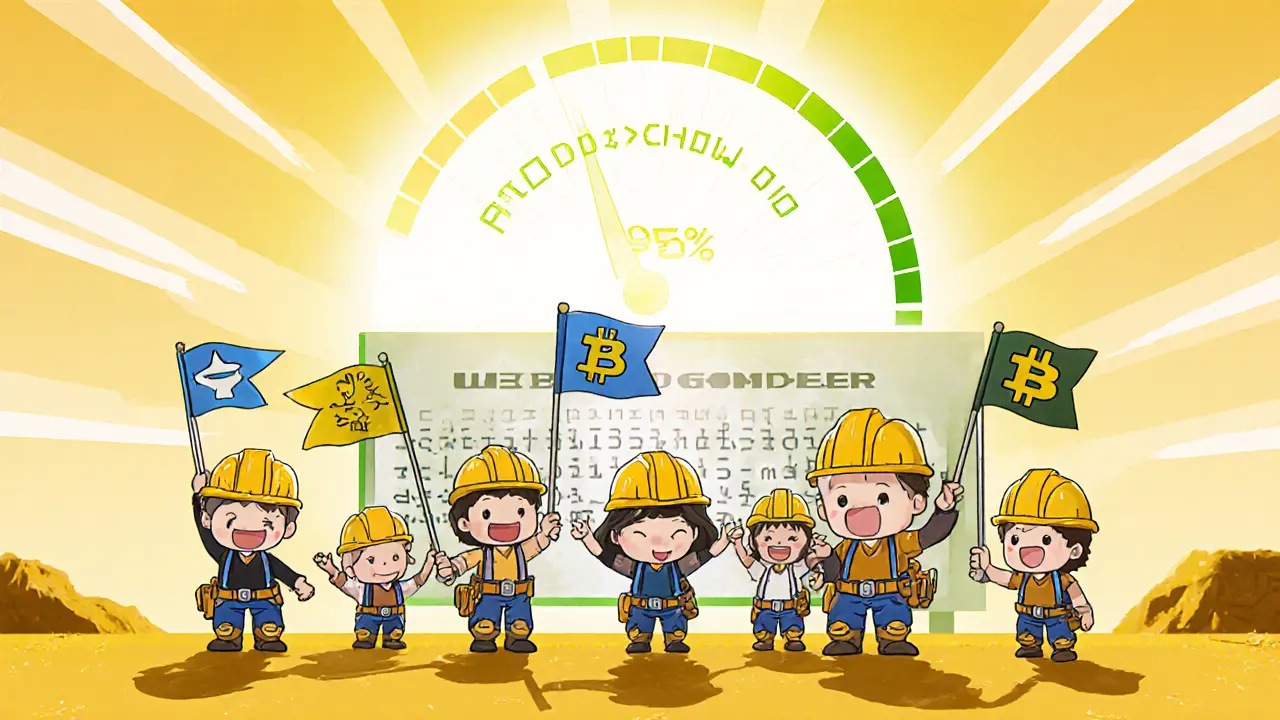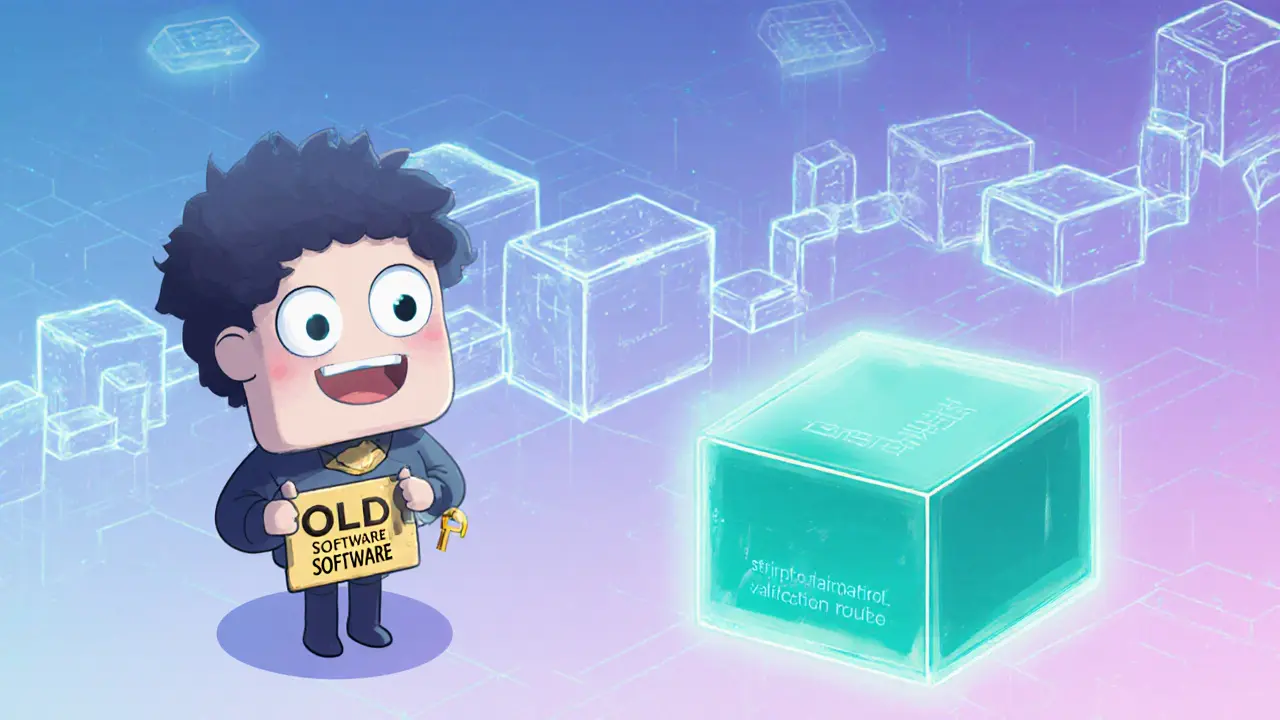Soft Fork Compatibility Checker
Examples of successful soft forks:
- SegWit (Segregated Witness): Improved transaction capacity by moving signature data out of the main block.
- P2SH (Pay-to-Script-Hash): Enabled complex scripts through simple hashes, maintaining compatibility.
- BIP66: Tightened DER encoding rules for ECDSA signatures to prevent vulnerabilities.
These upgrades demonstrate how soft forks enhance functionality while preserving backward compatibility.
Understanding soft fork backward compatibility is essential for anyone watching blockchain upgrades. It lets a network add new rules while older nodes keep working, avoiding the chaos of a chain split.
Quick Summary
- A soft fork introduces stricter rules that are a subset of the original protocol.
- Older nodes can still validate new blocks because the changes are backward‑compatible.
- Activation relies on miner or validator signaling rather than universal software updates.
- Soft forks avoid the chain‑splitting risk that hard forks carry.
- Real‑world examples include SegWit, P2SH, and BIP66.
What Is a Soft Fork?
In blockchain terminology, a Soft Fork is a protocol upgrade that tightens validation rules. Because the new rules form a subset of the old ones, any transaction or block that complies with the new rules automatically satisfies the old rules. This creates a one‑directional compatibility: new nodes accept everything old nodes do, but old nodes may reject some of the newer, more restrictive transactions.
How Backward Compatibility Works Under the Hood
When miners start producing blocks that follow the stricter criteria, they embed a signal-usually a specific version bit-in each block header. Nodes running the upgraded software see the signal and begin enforcing the new checks (e.g., tighter signature verification). Nodes that haven’t upgraded simply ignore the signal and continue using the original validation logic, which still sees the block as valid because the stricter rules are a subset.
This dual‑validation model hinges on three technical pillars:
- Validation Rules: New rules add constraints (such as requiring a specific script form). All old‑compatible transactions automatically meet these constraints.
- Miner Signaling: A majority of miners must signal readiness, typically using a version flag or a defined activation threshold.
- Consensus Threshold: Once the signaling threshold is crossed, the new rules become enforced network‑wide, but old nodes keep operating because they still see the blocks as valid.
Soft Fork vs. Hard Fork: A Side‑by‑Side Look
| Aspect | Soft Fork | Hard Fork |
|---|---|---|
| Rule Change Direction | More restrictive (subset) | Can relax or replace rules (superset) |
| Node Compatibility | Old nodes stay functional | Old nodes reject new blocks |
| Risk of Chain Split | Low - network stays unified | High - can create separate cryptocurrencies |
| Consensus Requirement | Majority of miners/validators | Super‑majority + coordinated upgrade |
| Typical Use Cases | Signature format upgrades, script enhancements | Fundamental parameter changes (e.g., block size limit) |

Real‑World Soft Forks That Shaped Bitcoin
The most cited examples come from Bitcoin’s own upgrade history.
- Segregated Witness (SegWit): Introduced a new transaction structure that moved signature data out of the main block, effectively increasing the usable block size. Older nodes still accepted SegWit blocks because the core transaction format remained unchanged.
- Pay‑to‑Script‑Hash (P2SH): Allowed complex scripts to be represented by a simple hash, letting users create multi‑signature wallets without modifying the base protocol. Compatibility was preserved because the hash‑based output was already valid under the original script rules.
- BIP66: Tightened the DER encoding rules for ECDSA signatures, fixing a long‑standing vulnerability. The change was backward‑compatible because non‑upgraded nodes still considered the stricter signatures valid.
Each of these upgrades followed the same pattern: miners signaled support, the network reached the activation threshold, and upgraded nodes began enforcing the new validation while older nodes kept working.
Activation Mechanics: From Signaling to Enforcement
The rollout typically follows a three‑stage process:
- Proposal: Developers publish a Bitcoin Improvement Proposal (BIP) or similar document describing the change.
- Signaling: Miners embed a version bit or use a lock‑in mechanism (e.g., BIP9) to show readiness. The network watches for a predefined percentage-often 95% of the last 2016 blocks.
- Enforcement: Once the threshold is met, nodes that have upgraded begin applying the new rules. Older nodes continue to validate blocks because the new blocks still satisfy the original criteria.
This staged approach lets developers test the change on a live network without forcing every participant to upgrade at once.
Benefits of Soft Fork Backward Compatibility
From a practical standpoint, soft forks deliver three core advantages:
- Stability: By avoiding a hard split, the network retains its full economic security and user base.
- Gradual Adoption: Businesses and wallet providers can upgrade on their own schedule, reducing operational risk.
- Security Enhancements: Stricter rules (e.g., improved signature verification) raise the overall safety of the protocol.
Limitations You Need to Know
Soft forks aren’t a silver bullet. Because they must remain a subset of the existing rules, they cannot introduce fundamentally new data structures or change consensus parameters that relax existing constraints. For instance, you can’t use a soft fork to double the block size limit; that would require a hard fork. Additionally, users on legacy software won’t reap the performance or fee‑saving benefits until they upgrade.
Future Directions: Making Soft Forks Even Smarter
Researchers are experimenting with more nuanced signaling methods, such as:
- Threshold‑free activation that uses on‑chain voting instead of fixed percentages.
- Hybrid upgrades that combine soft‑fork‑compatible changes with optional hard‑fork‑level features, giving developers extra flexibility.
These advances aim to keep the upgrade path smooth while expanding the scope of what can be achieved without breaking backward compatibility.

Frequently Asked Questions
What exactly makes a soft fork backward compatible?
A soft fork is backward compatible because it only adds rules that are stricter than the existing ones. Any block that follows the new rules also satisfies the old rules, so nodes running older software can still verify and accept those blocks.
How does miner signaling work?
Miners include a specific version bit or a predefined flag in the block header. The network watches the proportion of blocks containing that flag. When the set threshold (e.g., 95% over a difficulty period) is reached, the new rules become active.
Can a soft fork be used to increase block size?
No. Raising the block size limit would relax an existing rule, which violates the “more restrictive” requirement of a soft fork. Such a change needs a hard fork.
What are the most famous Bitcoin soft forks?
SegWit, Pay‑to‑Script‑Hash (P2SH), and BIP66 are the flagship examples. Each introduced valuable functionality while allowing older nodes to stay on the network.
Is a soft fork always safe?
Soft forks reduce the risk of a chain split, but they can still introduce bugs if the new stricter rules are not thoroughly tested. Proper signaling, community communication, and testnet trials are essential to keep the upgrade safe.




Danielle Thompson
August 13, 2025 AT 06:15Great breakdown! 😊
Alex Yepes
August 14, 2025 AT 15:35Thank you for the comprehensive overview of soft fork mechanics. The distinction between stricter rule subsets and the impact on legacy nodes is articulated with precision. It is noteworthy that miner signaling, often via version bits, serves as a democratic activation method. Moreover, the examples such as SegWit and BIP66 illustrate practical implementations of these principles. Overall, this exposition clarifies the delicate balance between innovation and network stability.
Susan Brindle Kerr
July 25, 1975 AT 17:18Honestly, this article feels like a sermon on the mount of blockchain purists.
It glorifies soft forks as if they are the holy grail, ignoring the messy reality of implementation.
The language is simple, yet the sentiment is pretentious, as if only the enlightened can appreciate the subtleties.
Every paragraph drips with self‑righteousness, declaring soft forks the only morally correct path.
The author never admits that some soft forks caused unforeseen vulnerabilities.
Meanwhile, the community suffers from the over‑idealization of “backward compatibility.”
The examples like SegWit are praised without mentioning the initial resistance and confusion it sparked among users.
One wonders why the piece refuses to discuss failed soft forks that left developers scrambling.
Perhaps the author believes any criticism would betray a lack of faith in Bitcoin’s destiny.
Such an attitude borders on dogmatism rather than constructive analysis.
The tone suggests that anyone who doubts the universality of soft forks is a heretic.
In reality, the blockchain ecosystem thrives on debate, not worship.
The article’s simplicity in vocabulary masks a deeper agenda to elevate soft forks above all alternatives.
It would benefit from acknowledging the legitimate technical trade‑offs involved.
Nevertheless, the narrative continues unabated, preaching the doctrine of compatibility without nuance.
In short, the piece is more a manifesto than an impartial guide.
Jared Carline
July 26, 1975 AT 23:52The analysis presented overlooks the geopolitical implications of protocol changes. While the technical description assumes neutrality, any alteration inevitably reshapes power dynamics among mining pools. It is essential to recognize that soft forks can be weaponized to marginalize dissenting participants. The author’s avoidance of such considerations reflects an overly formal and myopic perspective.
raghavan veera
July 28, 1975 AT 08:38Think of a soft fork as a gentle stream that nudges a river without breaking its banks. It’s a philosophical compromise where new ideas glide into the old structure, preserving continuity. The graceful signaling by miners mirrors a quiet consensus, a kind of silent meditation among participants.
Eric Levesque
July 29, 1975 AT 13:48Soft forks keep the chain strong and united.
alex demaisip
July 30, 1975 AT 20:55From a protocol engineering standpoint, the bifurcation of rule sets necessitates a deterministic activation threshold, typically quantified as a percentage of signaling blocks over a defined epoch. This ensures cryptographic finality while mitigating adversarial forks. The interplay of consensus rules and version bits embodies a multi‑layered governance model that scales with network hashpower.
Elmer Detres
August 1, 1975 AT 02:55Spot on! Soft forks are like a coach guiding a team without forcing a roster change. The gradual adoption lets everyone stay in the game, and the emojis just show the optimism. Keep it up! 🚀
Tony Young
August 2, 1975 AT 13:38What a dramatic illustration of blockchain evolution! 🎭 The article captures the tension between innovation and tradition, painting soft forks as heroic saviors. Yet, the stakes are real-each upgrade can ripple through countless wallets. The narrative balances technical depth with theatrical flair, making the content both informative and entertaining.
Fiona Padrutt
August 4, 1975 AT 01:45We must protect our network from any dilution of standards. A hard stance on compatibility ensures our sovereignty and keeps the chain pure.
Briana Holtsnider
August 5, 1975 AT 13:52The so‑called "soft fork" hype is just a smokescreen for lazy developers avoiding real change. Their superficial tweaks do nothing but lull the community into complacency.
Corrie Moxon
August 7, 1975 AT 00:35Great insights! It’s encouraging to see how soft forks can enhance security without fracturing the community. Let’s keep supporting thoughtful upgrades.
Jeff Carson
August 8, 1975 AT 07:08Interesting read! From a cultural perspective, the collaborative nature of soft forks mirrors how societies evolve-small adjustments that preserve identity while embracing progress. 👍
Anne Zaya
August 10, 1975 AT 00:48Nice article, really broke down the tech in a chill way.